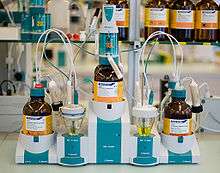Karl Fischer titration

Karl Fischer titration is a classic titration method in analytical chemistry that uses coulometric or volumetric titration to determine trace amounts of water in a sample. It was invented in 1935 by the German chemist Karl Fischer.[1] Today, the titration is done with an automatized Karl Fischer titrator.
Coulometric titration
The main compartment of the titration cell contains the anode solution plus the analyte. The anode solution consists of an alcohol (ROH), a base (B), SO2 and I2. A typical alcohol that may be used is methanol or diethylene glycol monoethyl ether, and a common base is imidazole.
The titration cell also consists of a smaller compartment with a cathode immersed in the anode solution of the main compartment. The two compartments are separated by an ion-permeable membrane.
The Pt anode generates I2 when current is provided through the electric circuit. The net reaction as shown below is oxidation of SO2 by I2. One mole of I2 is consumed for each mole of H2O. In other words, 2 moles of electrons are consumed per mole of water.
- B·I2 + B·SO2 + B + H2O → 2BH+I− + BSO3
- BSO3 + ROH → BH+ROSO3−
The end point is detected most commonly by a bipotentiometric method. A second pair of Pt electrodes are immersed in the anode solution. The detector circuit maintains a constant current between the two detector electrodes during titration. Prior to the equivalence point, the solution contains I− but little I2. At the equivalence point, excess I2 appears and an abrupt voltage drop marks the end point. The amount of charge needed to generate I2 and reach the end point can then be used to calculate the amount of water in the original sample.
Volumetric titration
The volumetric titration is based on the same principles as the coulometric titration except that the anode solution above now is used as the titrant solution. The titrant consists of an alcohol (ROH), base (B), SO2 and a known concentration of I2. Pyridine has been used as the base in this case.
One mole of I2 is consumed for each mole of H2O. The titration reaction proceeds as above, and the end point may be detected by a bipotentiometric method as described above.
Disadvantages and Advantages
The popularity of the Karl Fischer titration (henceforth referred to as KF) is due in large part to several practical advantages that it holds over other methods of moisture determination, such as accuracy, speed and selectivity.
KF is selective for water, because the titration reaction itself consumes water. In contrast, measurement of mass loss on drying will detect the loss of any volatile substance. However, the strong redox chemistry (SO2/I2) means that redox-active sample constituents may react with the reagents. For this reason, KF is unsuitable for solutions containing e.g. dimethyl sulfoxide.
KF has a high accuracy and precision, typically within 1% of available water, e.g. 3.00% appears as 2.97 - 3.03%. Although KF is a destructive analysis, the sample quantity is small and is typically limited by the accuracy of weighing. For example, in order to obtain an accuracy of 1% using a scale with the typical accuracy of 0.2 mg, the sample must contain 20 mg water, which is e.g. 200 mg for a sample with 10% water. For coulometers, the measuring range is from 1-5 ppm to ca. 5%. Volumetric KF readily measures samples up to 100%, but requires impractically large amounts of sample for analytes with less than 0.05% water.[2] The KF response is linear. Therefore, single-point calibration using a calibrated 1% water standard is sufficient and no calibration curves are necessary.
Little sample preparation is needed: a liquid sample can usually be directly injected using a syringe. The analysis is typically complete within a minute. However, KF suffers from an error called drift, which is an apparent water input that can confuse the measurement. The glass walls of the vessel adsorb water, and if any water leaks into the cell, the slow release of water into the titration solution can continue for a long time. Therefore, before measurement, it is necessary to carefully dry the vessel and run a 10-30 minute "dry run" in order to calculate the rate of drift. The drift is then subtracted from the result.
KF is suitable for measuring liquids and with special equipment, gases. The major disadvantage with solids is that the water has to be accessible and easily brought into methanol solution. Many common substances, especially foods such as chocolate, release water slowly and with difficulty, and require additional efforts to reliably bring the total water content into contact with the Karl Fischer reagents. For example, a high-shear mixer may be installed to the cell in order to break the sample. KF has problems with compounds with strong binding to water, as in water of hydration, for example with lithium chloride, so KF is unsuitable for the special solvent LiCl/DMAc.
KF is suitable for automation. Generally, KF is conducted using a separate KF titrator or for volumetric titration, a KF titration cell installed into a general-purpose titrator.
Using volumetric titration with visual detection of a titration endpoint is also possible with coloured samples by UV/VIS spectrophotometric detection.[3]
See also
Literature
- Water determination by Karl Fischer Titration by Peter A. Bruttel, Regina Schlink, Metrohm AG
References
- ↑ Fischer, Karl (1935). "Neues Verfahren zur maßanalytischen Bestimmung des Wassergehaltes von Flüssigkeiten und festen Körpern". Angew. Chem. 48 (26): 394–396. doi:10.1002/ange.19350482605.
- ↑ http://www.astm.org/Standards/E203
- ↑ Tavčar, E., Turk, E., Kreft, S. (2012). Simple Modification of Karl-Fischer Titration Method for Determination of Water Content in Colored Samples. Journal of Analytical Methods in Chemistry, Vol. 2012, Article ID 379724 http://www.hindawi.com/journals/jamc/2012/379724/